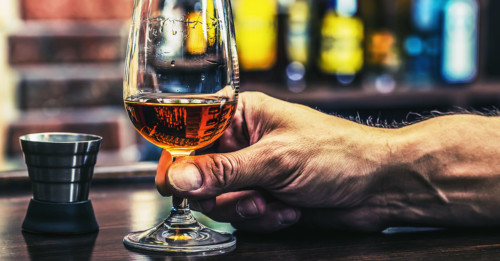If the only way you’ve tasted spirits was before a lime but after salt, or out of a giant snifter in the company of guys with pipes, there’s a lot left to discover. While shots—and rapidity—are the enemy of tasting spirits, so is anything too esoteric or rigid. Put simply, spirits should be tasted slowly but greedily—especially if you’re paying for them. The good news is, there’s no exact set of rules for tasting spirits, only some common sense that’s easy to follow:
Pour It Into A Glass
Okay, unless you’re part of some kind of fraternal toast, or at the blurry tail end of a very, very long New Year’s Eve, chances are you’re not drinking from the bottle. It’s useful to pour your spirit into a glass, and certain glassware works better than others. Not that you need to go buy the recommended glassware for each spirit—a general spirits-friendly tasting glass will do. Some professionals recommend Bordeaux wine glasses or small snifters, while others recommend tulip-shaped glasses with narrow mouths, to concentrate aromatics.
Taste At Room Temperature
We may keep certain spirits in the freezer, but all spirits, even supposedly flavorless vodka, should be first tasted at room temperature. At a warmer temperature, you’ll perceive more volatile aromatic compounds which the cold would just mask. Assuming your vodka is something you actually want to taste and not something you’re going to hide with cranberry juice, this is the way to do it.
Don’t Just Shoot It; Look At It
Yes, spirits are usually either clear or brown(ish), not extremely visually exciting. But there’s more there than meets the eye. Even clear spirits may leave “legs” on the glass, indicating a viscosity and giving you a sense of the mouthfeel. Also pay attention to clarity and even bubbles, which aren’t a result of carbonation but agitation, and occur only in higher (50% ABV and above) spirits. As for color, darker spirits have a range of colors, and lighter doesn’t always mean less flavor (since new, “virgin” casks will impart flavor, but not color, more rapidly). Caramel coloring can be added to some spirits to “color correct,” but shouldn’t impact flavor. And different woods, used in aging, will impart different colors and flavors.
Smell Before You Sip
This one’s easy, because it’s widely recommended for wine and beer drinking. You’ve heard it a million times: aromatics play a huge part in taste, and the aromatics of a spirit can be especially volatile, ready to leap out of the glass and into your nasal passageway if treated correctly. But be careful not to dunk your nose into the glass and inhale—that’ll just get you some burning alcohol and sideline your nasal passageways for a while. Instead, hold the glass just a little distance from your nose and inhale gently (with your mouth open or closed).
Sip, Spit, And Sip Again
Spirits aren’t generally part of what your palate encounters on a regular basis. It’s a bit of a (delightful) shock. So it’s good to prime your palate by sipping a little of the spirit, swishing it around, and spitting out the remainder. This is a kinder way to prep your palate, so it can pay attention to the second “tasting” sip. If you’re tasting cask strength (or higher proof alcohol), it’s useful to dilute it a bit to lower ethanol concentrations and open up the other aromatics. And most any spirit will benefit from another round of tasting with a bit of water.
